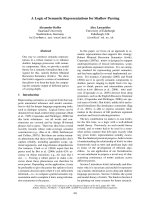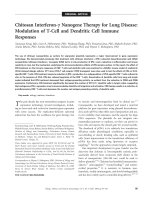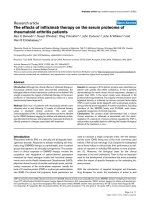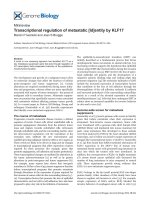Báo cáo y học: " Taking stock of gene therapy for cystic fibrosis" pdf
Bạn đang xem bản rút gọn của tài liệu. Xem và tải ngay bản đầy đủ của tài liệu tại đây (127.16 KB, 4 trang )
Commentary
Taking stock of gene therapy for cystic fibrosis
Myra Stern, Duncan M Geddes and Eric WFW Alton
Imperial College at the National Heart and Lung Institute, London, UK
Abstract
The identification of the cystic fibrosis (CF) gene opened the way for gene therapy. In the ten
years since then, proof of principle in vitro and then in animal models in vivo has been
followed by numerous clinical studies using both viral and non-viral vectors to transfer normal
copies of the gene to the lungs and noses of CF patients. A wealth of data have emerged
from these studies, reflecting enormous progress and also helping to focus and define key
difficulties that remain unresolved. Gene therapy for CF remains the most promising
possibility for curative rather than symptomatic therapy.
Keywords: cationic lipids, CFTR, cystic fibrosis, gene therapy, recombinant viruses
Received: 28 April 2000
Revisions requested: 25 May 2000
Revisions received: 1 September 2000
Accepted: 1 September 2000
Published: 15 September 2000
Respir Res 2000, 1:78–81
The electronic version of this article can be found online at
/>© Current Science Ltd (Print ISSN 1465-9921; Online ISSN 1465-993X)
AAV = adeno-associated virus; CF = cystic fibrosis.
/>The cloning of the CF gene with subsequent characterisa-
tion of its protein (CFTR) [1] opened the way for gene and
protein therapy. The idea was simply to administer the
normal CF gene or protein, as though it were a drug, to
the organ most affected yet apparently quite accessible:
the lungs. In theory this should result in the restoration of
normal cellular function and thus prevent or treat the
disease. A vigorous research effort followed the identifica-
tion of the gene; the first reports of CFTR gene transfer in
vitro appeared in 1990 [2], only one year later. Further
studies in vitro [3] were followed by gene transfer in vivo
to the airway epithelial cells of transgenic CF mice [4,5],
confirming that it was possible to achieve some functional
restoration of the ion transport defects in these cells after
transgene expression. Within four years, four clinical
studies of gene therapy in CF patients had been reported;
since then there have been over 20 phase I studies.
Several of these trials used adenoviral vectors to transfer
CFTR cDNA to adult volunteers with CF; many of these
trials have now been reported [6–13]. Some early studies
reported acute inflammation, which was probably related
to the local instillation of a high viral load. There has been
evidence of gene transfer as determined by the detection
of mRNA or CFTR protein, although this was not a con-
sistent finding. Electrophysiological correction has been
suggested in some studies, but only one study was con-
trolled and this showed limited evidence of gene transfer
at the highest dose, with no evidence of functional cor-
rection. Two clinical trials with adeno-associated virus
/>commentary
review
reports primary research
(AAV) as the gene transfer agent have also been reported
[14,15]. No significant side effects have been observed
and some evidence of correction of the chloride defect
has been suggested.
Liposome–plasmid complexes have been tested in several
clinical trials [16–21]. Of these, five were double-blind
placebo-controlled studies. Three trials with a similar
design showed a partial correction of the chloride trans-
port defect in the nose [16–18]. In a further study, com-
plexes were delivered to the lungs by nebulisation [20]
with an approximate 20% restoration of chloride transport
towards normal values. Administration was associated
with a transient febrile reaction that did not occur in the
control group, who received only the lipid; this reaction
might have been attributable to the bacterial origin of the
DNA [22]. None of these studies showed any correction
of the sodium defect, and vector-specific mRNA was only
inconsistently found.
A wealth of data have emerged from all of these studies,
reflecting enormous progress but also helping to focus on
the key difficulties. The principal issue is to improve the
efficiency of gene transfer, but questions relating to the
level of efficiency needed and the target cell population
also need addressing. The key problem of efficiency can
be considered in terms of either improving vectors or over-
coming biological barriers. An intrinsic function of the
lining epithelium of the airways is to prevent penetration by
foreign materials and invading organisms. Thus, a complex
series of epithelial barriers, including a mucous layer that
inhibits gene transfer [23], a glycocalyx, an apical cell
membrane and tight junctions between the cells, conspire
to keep out intraluminally delivered materials, including
both viral and non-viral vectors. This problem is com-
pounded in CF by the presence of thick, infected sputum,
also known to inhibit gene transfer [24], and plugging of
the small airways with mucus. The use of adjunctive
mucolytic agents or the abrogation of tight junction barrier
function either with detergents or with antibodies against
intrinsic tight junction components, are just two novel
strategies being investigated to overcome these barriers.
In addition, much effort is being devoted to the modifica-
tion of vectors. For adenovirus, AAV and other viruses, the
appropriate receptors are largely confined to the basolat-
eral cell membrane. Thus, attempts are now being made to
adapt viral entry by using apically sited receptors such as
the UTP-binding P2Y2 receptor. Novel viruses are
increasingly being investigated, and cationic liposomes
and polymers are increasingly being coupled to peptides,
sugars and viral particles to try to increase gene transfer
efficiency. The vexing question of how much effective
gene delivery and expression is required to achieve clinical
benefit remains unresolved, but the level is likely to be low.
If gene transfer is achieved in only a certain proportion of
cells within the airway epithelium, then studies suggest
that 6–10% of cells need to be corrected to reverse the
chloride defect and 100% for the sodium defect [25,26].
If, in contrast, delivery occurs to every cell, then levels of
approximately 5% of normal CFTR mRNA can correct the
chloride defect and reverse the intestinal pathology in CF
mice [27]. These goals have not yet been reached but the
relatively low levels that might be needed are encouraging.
CF affects the conducting airways rather than the alveoli.
These include both the larger bronchial regions lined by a
pseudostratified columnar epithelium and containing
numerous submucosal glands, and the small bronchiolar
regions lined by a simple columnar epithelium devoid of
glands. A central question for CF gene therapy is which
cell type and which region (large or small airways) to
target. Although ciliated superficial epithelium is abundant
and displays the ion transport defects in patients with CF,
the submucosal glands are the cells expressing the
highest CFTR levels in the lung and might well need to be
targeted for clinical benefit. This raises considerations of
delivery, because topical application is unlikely to reach
these cells. Further, most results suggest that small
airways are both the initial and the major site of disease in
CF. Again, the effective delivery of cDNA to these areas is
difficult with present nebuliser technology and remains an
important strategic issue.
A final important issue relates to repeated application. All
of the current vectors are likely to produce episomal gene
transfer, and the current duration of expression after a
single application is measurable in weeks. This does not
matter as long as multiple applications are feasible. In this
regard, cationic liposomes seem to have an important
advantage, with a third application having been shown to
be as effective as the first in a recent trial of multiple appli-
cations of liposome-mediated gene therapy to the nasal
epithelium of CF patients [28]. The repeated administra-
tion of viral vectors results in the production of neutralising
antibodies that limit reapplication efficiency, and consider-
able effort is being expended to reduce this problem.
Gene therapy will probably prove to be most beneficial if
given very early, before the onset of established infection
or inflammation in the lungs. Thus, questions about the
execution and design of trials in the paediatric population
are likely to become the focus of new efforts [29]. The rig-
orous measurement of gene transfer efficiency in vivo and
the development of markers – both real and surrogate – of
clinical benefit also remain important challenges.
In conclusion, CFTR gene therapy has proved to be safe
so far and has produced a proof of principle with respect
to CFTR function in the target organ in humans, an
encouraging position in a young field. Nevertheless, it is
not yet a clinically effective treatment for CF lung disease.
Respiratory Research Vol 1 No 2 Stern et al
The inevitable pessimism that follows unrealistic expecta-
tions of a rapid cure has dogged the recent media view of
gene therapy. Gene therapy is clearly at the typical stage
of new drug development where considerable and
unglamorous effort needs to be expended to move from
proof of principle to clinical product. Encouraging
progress in gene therapy can clearly be found both within
the CF field and in parallel areas. Thus, a clinical study of
intramuscular injection of an AAV vector expressing factor
IX in adults with severe haemophilia B [30] demonstrated
prolonged expression of the protein and positive changes
in clinical endpoints, including circulating levels of factor
IX and the frequency of infusion of factor IX protein. The
questions that remain to be answered for successful CF
gene therapy have now been clearly defined, and gene
therapy for CF remains the most promising possibility for
curative rather than symptomatic therapy.
References
1. Riordan JR, Rommens JM, Kerem B, Alon N, Rozmahel R, Grzelczak Z,
Zielenski J, Lok S, Plavsic N, Chou JL, Drumm ML, Iannuzzi MC, Collins
FS, Tsui LC: Identification of the cystic fibrosis gene: cloning and
characterization of complementary DNA. Science 1989, 245:1066–
1073.
2. Drumm ML, Pope HA, Cliff WH, Rommens JM, Marvin SA, Tsui LC,
Collins FS, Frizzell RA, Wilson JM: Correction of the CF defect in vitro
by retrovirus-mediated gene transfer. Cell 1990, 62:1227–1233.
3. Rich DP, Anderson MP, Gregory RJ, Cheng SH, Paul S, Jefferson DM,
McCann JD, Klinger KW, Smith AE, Welsh MJ: Expression of cystic
fibrosis transmembrane conductance regulator corrects defective
chloride channel regulation in cystic fibrosis airway epithelial
cells. Nature 1990, 347:358–363.
4. Hyde SC, Gill DR, Higgins CF, Trezise AE, MacVinish LJ, Cuthbert
AW, Ratcliff R, Evans MJ, Colledge WH: Correction of the ion trans-
port defect in cystic fibrosis transgenic mice by gene therapy.
Nature 1993, 362:250–255.
5. Alton EWFW, Middleton PG, Caplen NJ, Smith SN, Steel DM, Munkonge
FM, Jeffery PK, Geddes DM, Hart SL, Williamson R, Fasold KI, Miller AD,
Dickinson P, Stevenson BJ, McLachlan G, Dorin JR, Porteous DJ: Non-
invasive liposome-mediated gene delivery can correct the ion trans-
port defect in cystic fibrosis mice. Nat Genet 1993, 5:135–142.
6. Zabner J, Couture RA, Gregory RJ, Graham SM, Smith AE, Welsh MJ:
Adenovirus-mediated gene transfer transiently corrects the chlo-
ride transport defect in nasal epithelia of patients with cystic fibro-
sis. Cell 1993, 75:207–216.
7. Crystal RG, McElvaney NG, Rosenfeld MA, Chu CS, Mastrangeli A,
Hay JG, Brody SL, Jaffe HA, Eissa NT, Danel C: Administration of an
adenovirus containing the human CFTR cDNA to the respiratory
tract of individuals with cystic fibrosis. Nat Genet 1994, 8:42–51.
8. Knowles MR, Hohneker KW, Zhou Z, Olsen JC, Noah TL, Hu PC,
Leigh MW, Engelhardt JF, Edwards LJ, Jones KR, Grossman M,
Wilson JM: A controlled study of adenoviral-vector-mediated gene
transfer in the nasal epithelium of patients with cystic fibrosis. N
Engl J Med 1995, 333:823–831.
9. Zabner J, Ramsey BW, Meeker DP, Aitken ML, Balfour RP, Gibson RL,
Launspach J, Moscicki RA, Richards SM, Standaert TA, Williams-
Warren J, Wadsworth SC, Smith AE, Welsh MJ: Repeat administra-
tion of an adenovirus vector encoding cystic fibrosis
transmemebrane conductance regulator to the nasal epithelium
of patients with cystic fibrosis. J Clin Invest 1996, 97:1504–1511.
10. Bellon G, Michel-Calemard L, Thouvenot D, Jagneaux V, Poitevin F,
Malcus C, Accart N, Layani MP, Aymard M, Bernon H, Bienvenu J,
Courtney M, Doring G, Gilly B, Gilly R, Lamy D, Levrey H, Morel Y,
Paulin C, Perraud F, Rodillon L, Sene C, So S, Touraine-Moulin F,
Pavirani A: Aerosol administration of a recombinant adenovirus
expressing CFTR to cystic fibrosis patients: a phase I clinical trial.
Hum Gene Ther 1997, 1:15–25.
11. Harvey BG, Leopold PL, Hackett NR, Grasso TM, Williams PM, Tucker
AL, Kaner RJ, Ferris B, Gonda I, Sweeney TD, Ramalingam R, Kovesdi
I, Shak S, Crystal RG: Airway epithelial CFTR mRNA expression in
cystic fibrosis patients after repetitive administration of a recom-
binant adenovirus. J Clin Invest 1999, 4:1245–1255.
12. Zuckerman JB, Robinson CB, McCoy KS, Shell R, Sferra TJ, Chirmule
N, Magosin SA, Propert KJ, Brown-Parr EC, Hughes JV, Tazelaar J,
Baker C, Goldman MJ, Wilson JM: A phase I study of adenovirus-
mediated transfer of the human cystic fibrosis transmembrane
conductance regulator gene to a lung segment of individuals with
cystic fibrosis. Hum Gene Ther 1999, 18:2973–2985.
13. Bellon G, Fau C, Michel L, Thouvenot D, Rodillon L, Bienvenue J,
Malcus C, Levery H, Squiban P, Pavirani A: CFTR gene transfer by
repeated administration of recombinant adenovirus to the nasal
mucosa of cystic fibrosis patients. Paediatr Pulmonol Suppl 1999,
9:210.
14. Wagner JA, Reynolds T, Moran ML, Moss RB, Wine JJ, Flotte TR,
Gardner P: Efficient and persistent gene transfer of AAV-CFTR in
the maxillary. Lancet 1998, 651:1702–1703.
15. Wagner JA, Messner AH, Moran ML, Guggino WB, Flotte TR, Wine JJ,
Carter BJ, Batson EP, Moss RB, Gardner P: A phase II double-blind
randomised controlled clinical trial of tgAVCF using maxillary
sinus delivery in CF patients with antrostomies. Paediatr Pulmonol
Suppl 1999, 19:209.
16. Caplen NJ, Alton EW, Middleton PG, Dorin JR, Stevenson BJ, Gao X,
Durham SR, Jeffery PK, Hodson ME, Coutelle C, Huang L, Porteous
DJ, Williamson R, Geddes DM: Liposome mediated CFTR gene
transfer to the nasal epithelium of patients with cystic fibrosis. Nat
Med 1995, 1:39–46.
17. Gill DR, Southern KW, Mofford KA, Seddon T, Huang L, Sorgi F,
Thomson A, MacVinish LJ, Ratcliff R, Bilton D, Lane DJ, Littlewood JM,
Webb AK, Middleton PG, Colledge WH, Cuthbert AW, Evans MJ,
Higgins CF, Hyde SC: A placebo controlled study of liposome-
mediated gene transfer to the nasal epithelium of patients with
cystic fibrosis. Gene Ther 1997, 4:199–209.
18. Porteous DJ, Dorin JR, McLachlan G, Davidson-Smith H, Davidson H,
Stevenson BJ, Carothers AD, Wallace WA, Moralee S, Hoenes C,
Kallmeyer G, Michaelis U, Naujoks K, Ho LP, Samways JM, Imrie M,
Greening AP, Innes JA: Evidence for safety and efficacy of DOTAP
cationic liposome-mediated CFTR gene transfer to the nasal
epithelium of patients with cystic fibrosis. Gene Ther 1997, 4:
210–218.
19. Zabner J, Cheng SH, Meeker D, Launspach J, Balfour R, Perricone
MA, Morris JE, Marshall J, Fasbender A, Smith AE, Welsh MJ: Com-
parison of DNA–lipid complexes and DNA alone for gene transfer
to cystic fibrosis airway epithelium in vivo. J Clin Invest 1997, 100:
1529–1537.
20. Alton EW, Stern M, Farley R, Jaffe A, Chadwick SL, Phillips J, Davies J,
Smith SN, Browning J, Davies MG, Hodson ME, Durham SR, Li D,
Jeffery PK, Scallan M, Balfour R, Eastman SJ, Cheng SH, Smith AE,
Meeker D, Geddes DM: Cationic lipid-mediated CFTR gene trans-
fer to the lungs and nose of patients with cystic fibrosis: a double-
blind placebo-controlled trial. Lancet 1999, 353:947–954.
21. Noone PG, Hohneker KW, Zhou Z, Johnson LG, Foy C, Gipson C,
Jones K, Noah TL, Leigh MW, Schwartzbach C, Efthimiou J, Pearlman
R, Boucher RC, Knowles MR: Safety and efficacy of a lipid–CFTR
complex for gene transfer in the nasal epithelium of adult patients
with cystic fibrosis. Mol Ther 2000, 1:105–114.
22. Schwartz DA, Quinn TJ, Thorne PS, Sayeed S, Yi AK, Krieg AM: CpG
motifs in bacterial DNA cause inflammation in the lower respira-
tory tract. J Clin Invest 1997, 100:68–73.
23. Kitson C, Angel B, Judd D, Rothery S, Severs NJ, Dewar A, Huang L,
Wadsworth SC, Cheng SH, Geddes DM, Alton EW: The extra- and
intracellular barriers to lipid and adenovirus-mediated pulmonary
gene transfer in native sheep airway epithelium. Gene Ther 1999,
6:534–546.
24. Stern M, Caplen NJ, Browning JE, Griesenbach U, Sorgi F, Huang L,
Gruenert DC, Marriot C, Crystal RG, Geddes DM, Alton EW: The
effect of mucolytic agents on gene transfer across a CF sputum
barrier in vitro. Gene Ther 1998, 5:91–98.
25. Johnson LG, Olsen JC, Sarkadi B, Moore KL, Swanstrom R, Boucher
RC: Efficiency of gene transfer for restoration of normal airway
epithelial function in cystic fibrosis. Nat Genet 1992, 2:21–25.
26. Johnson LG, Boyles SE, Wilson J, Boucher RC: Normalisation of
raised sodium absorption and raised calcium-mediated chloride
secretion by adenovirus-mediated expression of cystic fibrosis
transmembrane conductance regulator in primary human cystic
fibrosis airway epithelial cells. J Clin Invest 1995, 95:1377–1382.
27. Dorin JR, Farley R, Webb S, Smith SN, Farini E, Delaney SJ, Wain-
wright BJ, Alton EW, Porteous DJ: A demonstration using mouse
/>commentary
review
reports primary research
models that successful gene therapy for cystic fibrosis requires
only partial gene correction. Gene Ther 1996, 3:797–801.
28. Hyde SC, Southern KW, Gileadi U, Fitzjohn EM, Mofford KA, Waddell
BE, Gooi HC, Goddard CA, Hannavy K, Smyth SE, Egan JJ, Sorgi FL,
Huang L, Cuthbert AW, Evans MJ, Colledge WH, Higgins CF, Webb
AK, Gill DR: Repeat administration of DNA liposomes to the nasal
epithelium of patients with cystic fibrosis. Gene Ther 2000, 13:
1156–1165.
29. Jaffe A, Bush A, Geddes DM, Alton EW: Prospects for gene therapy
in cystic fibrosis. Arch Dis Child 1999, 80:286–289.
30. Kay MA, Manno CS, Ragni MV, Larson PJ, Couto LB, McClelland A,
Glader B, Chew AJ, Tai SJ, Herzog RW, Arruda V, Johnson F, Scallan
C, Skarsgard E, Flake AW, High KA: Evidence for gene transfer and
expression of factor IX in haemophilia B patients treated with an
AAV vector. Nat Genet 2000, 24:257–261.
Authors’ affiliation: Department of Gene Therapy, Imperial College at
the National Heart and Lung Institute, London, UK
Correspondence: Myra Stern, Department of Gene Therapy, Imperial
College at the National Heart and Lung Institute, Manresa Road,
London SW3 6LR, UK. Tel: +44 20 7351 8339;
fax: +44 20 7351 8340; e-mail:









